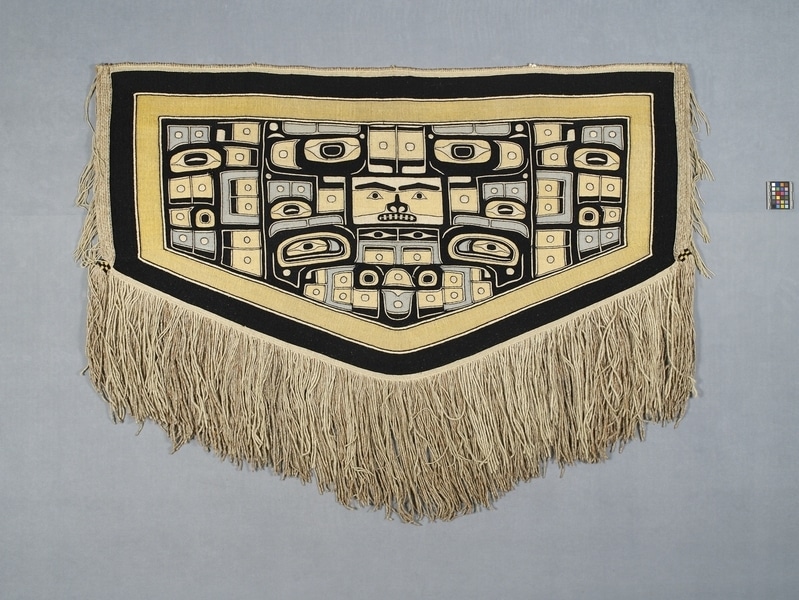Chilkat Robe Item Number: A4454 from the MOA: University of British Columbia


Description
Chilkat style robe with woven designs and fringe. The design is a three panel distributive. In the centre is an ancestor face surrounded by a diving whale (?) motif. The side panels continue the diving whale motif. The design is yellow, blue and black on natural ground. The two bottom corners have a checkered pattern in black and yellow, associated with the identity of the weaver. There is a long twisted fringe on three sides of mixed wool and cedar bark.
History Of Use
Weaving blankets from mountain goat wool mixed with shredded cedar bark is an ancient and complex tradition. The techniques were kept alive by the Tlingit, who acquired weaving knowledge through marriage with the Tsimshian. The robes were traded along the coast to be worn on ceremonial occasions by Haida, Tsimshian and Kwakwaka'wakw chiefs. Chilkat robes were symbols of wealth: to own them endowed a chief with prestige. Even greater prestige resulted from giving them away in potlatch. If there was no chief attending of high enough rank to receive it, the blanket might be cut into strips and distributed to a number of persons of prestige. These strips would be made into other ceremonial garments, such as shirts, aprons, leggings, headdresses, or bags. In recent years, weavers from other coastal communities have relearned the techniques, using sheep’s wool with cedar, to produce modern versions for ceremonial use.
Cultural Context
ceremonial
Specific Techniques
The design would have been first painted onto a pattern board by a male artist, then precisely copied in weaving by a female weaver. The style operated within strict conventions, but at the same time permitting subtle individual variations and originality. The weaving technique evolved from the craft of finger twining yellow cedar bark blankets. Bark may still form the core of the warp strands, handspun with mountain-goat wool. The handspun woolen weft may be left white, or dyed with hemlock bark for black, wolf moss for yellow, adding blue from copper or trade blankets to achieve a blue-green for different areas of the design. The loom consists of two upright posts, and a broad crossbeam from which the warp hangs freely. In this piece the warp threads are folded in half at the top edge over a length of 2-ply cedar bark. The warp ends are divided into sections and inserted into gut bags to keep the warps clean and untangled during twining. Weaving proceeds from top to bottom of the blanket, and extra warps are added when the design field is completed, in order to produce the curved border at the bottom.
Item History
- Made in Alaska, USA ? during 1900
- Owned by Sidney G. Smith before January 17, 1957
- Received from Sidney G. Smith (Donor) on January 17, 1957
What
- Name
- Chilkat Robe
- Identification Number
- A4454
- Type of Item
- robe
- Material
- dye, wolf moss dye ?, wool fibre, cedar bark and mountain goat wool fibre
- Manufacturing Technique
- spun, dyed and woven
- Overall
- height 133.0 cm, width 173.0 cm
Who
- Culture
- Tlingit
- Previous Owner
- Sidney G. Smith
- Received from
- Sidney G. Smith (Donor)
Where
- Holding Institution
- MOA: University of British Columbia
- Made in
- Alaska, USA ?
When
- Creation Date
- during 1900
- Ownership Date
- before January 17, 1957
- Acquisition Date
- on January 17, 1957
Other
- Item Classes
- textiles
- Condition
- good
- Current Location
- Case 26
- Accession Number
- 1925/0001